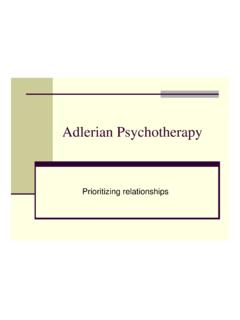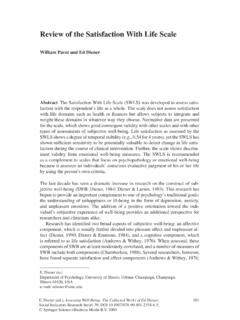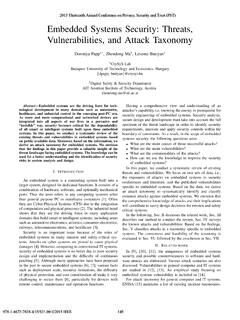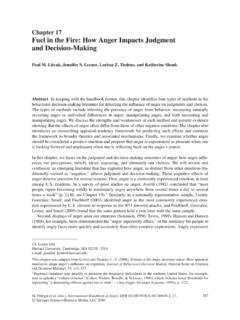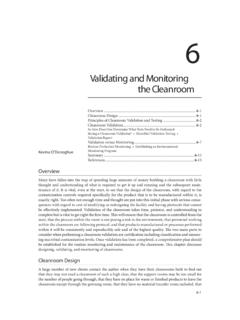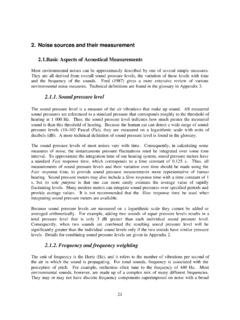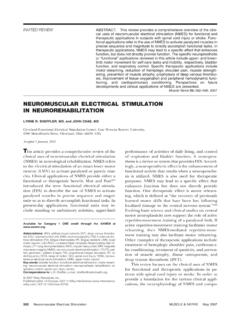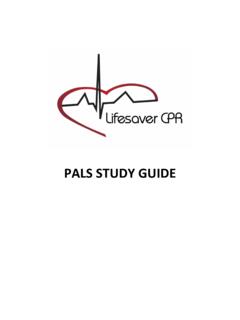Transcription of Cognitive Behavioral Therapy for Eating Disorders
1 Cognitive Behavioral Therapy for Eating Disorders Anorexia nervosa Bulimia nervosa Binge Eating disorder Eating disorder NOS Eating Disorders Anorexia nervosa Bulimia nervosa Binge Eating disorder Eating disorder NOS Eating Disorders ED-NOS AN BN BED ED-NOS AN BN BED No empirically supported treatment CBT leading empirically-supported treatment: 40% to 50% of those who complete CBT-BN make a full and lasting recovery Just one treatment study Leading treatment is guided CB self-help Bulimia Nervosa Self-evaluation is unduly influenced by body shape and weight Binge Eating Compensatory behaviors Bulimia Nervosa Self-evaluation is unduly influenced by body shape and weight Almost all BN diet at some point before the onset of the disease Many BN patients used to meet diagnosis of AN Bulimia Nervosa Self-evaluation is unduly influenced by body shape and weight Binge Eating Binge Eating Eating a greater amount
2 Of food in a fixed period of time ( , 2 hours) than what most people would eat in the same time period and circumstances AND Accompanied by a sense of lack of control over what and how much one is Eating Other characteristics: May be planned or spontaneous Usually done in secret Often triggered by unhappy moods Often people eat until they are uncomfortably full and feel ashamed } For example, a binge might involve consuming all of the following in a very rapid amount of time (and in private): a. a whole box of cookies b. 2 liter bottle of soda c. a gallon of ice cream d.
3 A large bag of chips Bulimia Nervosa Self-evaluation is unduly influenced by body shape and weight Binge Eating Compensatory behavior For example: Vomiting Laxatives Excessive exercise Fasting Compensatory behaviors TREATMENT --CBT What do we do? Distinction between causes and treatment? Bulimia Nervosa Distal antecedent: Parents being over-controlling Being teased about appearances Genes .. Proximal antecedent: Dysfunctional thoughts Dysfunctional behaviors that directly leads to the BN symptoms Binge Eating Compensatory vomiting/laxative misuse Events and associated mood change Over-evaluation of shape and weight and their control Strict dieting; non-compensatory weight-control behavior abcdefBehavioral Components Binge Eating Compensatory vomiting/laxative misuse Events and associated mood change Over-evaluation of shape and weight and their control Strict dieting.
4 Non-compensatory weight-control behavior abcdefBULIMIA NERVOSA Available as a pdf from Binge Eating Compensatory vomiting/laxative misuse Events and associated mood change Over-evaluation of shape and weight and their control Strict dieting; non-compensatory weight-control behavior abcdefBinge Eating Compensatory vomiting/laxative misuse Events and associated mood change Over-evaluation of shape and weight and their control Strict dieting; non-compensatory weight-control behavior abcdefTreatment of Eating Disorders Three parts of CBT for Eating Disorders Part I: Behavioral symptoms related to food and appearance Part II: Cognitive Symptoms related to Eating Disorders Part III: Relapse Prevention BEHAVIORS 1.
5 Establish real-time self-monitoring 2. Establish a pattern of regular Eating 3. Dietary restraint SELF-MONITORING Rationale Helps patients distance themselves from the processes that are maintaining their Eating disorder, and thereby begin to recognise and question them Self-monitoring SELF-MONITORING Rationale Helps patients distance themselves from the processes that are maintaining their Eating disorder, and thereby begin to recognise and question them Highlights key behaviour, feelings and thoughts, and the context in which they occur makes experiences that seems automatic and out of control more amenable to change COLLABORATIVE WEIGHING Rationale Patients with Eating Disorders are unusual in their frequency of weighing frequent weighing encourages concern about inconsequential changes in weight.
6 And thereby maintains dieting avoidance of weighing is as problematic Knowledge of weight is a necessary part of treatment permits examination of the relationship between Eating and weight facilitates change in Eating habits necessary for addressing any associated weight problem one aspect of the addressing of the over-evaluation of weight COLLABORATIVE WEIGHING Procedure No weighing at home (but transfer to at-home weighing late in treatment) but patient and therapist weighing the patient at the beginning of each (weekly) session joint plotting of a weight graph repeated examination of trends over the preceding four readings continual reinforcement of One can t interpret a single reading REGULAR Eating Key intervention for all patients (including underweight ones) Rationale Foundation upon which other changes in Eating are built Gives structure to the patient s Eating habits (and day) Provides meals and snacks which can then be modified Addresses one form of dieting (skipping meals) Displaces binge Eating Procedure Help patients eat at regular intervals through the day.
7 Without Eating in the gaps .. what they eat does not matter at this stage Strict dieting Restraint (attempted under- Eating ) Restriction (actual under- Eating ) ADDRESSING DIETARY RESTRAINT ADDRESSING DIETARY RESTRAINT Remind patients that (for them) dietary restraint is a problem, not a solution Identify the main forms of restraint delayed Eating already addressed avoidance of specific foods ADDRESSING DIETARY RESTRAINT Food avoidance Identify avoided foods Categorise them Systematically introduce (as behavioural experiments) Exposure Food == fat Avoid food Did not get fat Eat food, did not get fat, food not equal to fat IDENTIFY AND CHALLENGE DIETARY RULES Identify other dietary rules and rituals: Not Eating more than 600 kcals daily Not Eating before pm Not Eating in front of others Eating less than others present Not Eating food of unknown composition COGNITIONS Whilst continuing with the strategies and procedures introduced in Stage One, address the main maintaining mechanisms operating in the individual patient s case.
8 1. Over-evaluation of shape and weight 2. Over-evaluation of control over Eating 3. Event-related changes in Eating Binge Eating Compensatory vomiting/laxative misuse Events and associated mood change Over-evaluation of shape and weight and their control Strict dieting; non-compensatory weight-control behavior abcdefThe core psychopathology of Eating Disorders is the over-evaluation of shape and weight self-worth is judged largely or exclusively in terms of shape and weight and the ability to control them other modes of self-evaluation are marginalised most other features appear to be secondary to the core psychopathology dieting repeated body checking and/or body avoidance pronounced feeling fat ADDRESSING THE OVER-EVALUATION OF SHAPE OR WEIGHT FamilyWorkShape, weightand eatingOtherFriendsSportMusicFamilyWorkSh ape.
9 Weightand eatingOtherExpand the formulation ADDRESSING THE OVER-EVALUATION OF SHAPE OR WEIGHT (cont) Over-evaluation of shape and weight and their control Dietary restraint Shape and weight checking and/or avoidance Preoccupation with thoughts about shape and weight Marginalisation of other areas of life Mislabelling adverse states as feeling fat ADDRESSING THE OVER-EVALUATION OF SHAPE OR WEIGHT 2. Address the over-evaluation using two strategies: Develop new domains for self-evaluation Reduce the importance of shape and weight Develop new domains for self-evaluation encourage patients to identify and engage in (neglected) interests and activities, especially those of a social nature ADDRESSING THE OVER-EVALUATION OF SHAPE OR WEIGHT Binge Eating Breaking a dietary rule.
10 Being disinhibited ( , alcohol) .. Under- Eating .. Adverse event or mood .. Lessons to learn: .. Binge Analysis Available as a pdf from ENHANCING PROBLEM-SOLVING Step 1 The problem should be identified and specified as early as possible Step 2 All possible ways of dealing with the problem should be considered Step 3 Their likely effectiveness and feasibility should be considered Step 4 One alternative should be chosen Step 5 The steps required to carry out the chosen solution should be defined Step 6 The solution should be acted upon Step 7 Subsequently the entire problem-solving process should be evaluated
